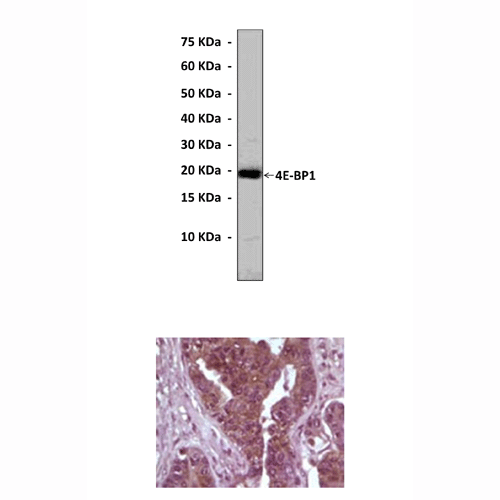Anti-4E-BP1: Mouse Monoclonal 4E-BP1 Antibody |
 |
BACKGROUND 4E-BP1 (also called PHAS-I, eIF4E-binding protein 1) is one member of a family of translation repressor proteins. The protein directly interacts with eukaryotic translation initiation factor 4E (eIF4E), which is a limiting component of the multisubunit complex that recruits 40S ribosomal subunits to the 5' end of mRNAs. Interaction of this protein with eIF4E inhibits complex assembly and represses translation. This protein is phosphorylated in response to various signals including UV irradiation and insulin signaling, resulting in its dissociation from eIF4E and activation of mRNA translation.1,2 It mediates the regulation of protein translation by hormones, growth factors and other stimuli that signal through the MAP kinase and mTORC1 pathways.3
REFERENCES
1. Gingras, A.C. et al: Gene Dev. 12:502-13, 1998
2. Yamaguchi, S. et al: Cell Metabol. 7:269-276, 2008
3. Gingras, A.C. et al: Gene Dev. 13:1422-1437, 1999
2. Yamaguchi, S. et al: Cell Metabol. 7:269-276, 2008
3. Gingras, A.C. et al: Gene Dev. 13:1422-1437, 1999
Products are for research use only. They are not intended for human, animal, or diagnostic applications.
Параметры
Cat.No.: | CP10001 |
Antigen: | Purified recombinant human 4E-BP1 expressed in E. coli. |
Isotype: | Mouse IgG1 |
Species & predicted species cross- reactivity ( ): | Human, Mouse, Rat |
Applications & Suggested starting dilutions:* | WB 1:1000 IP n/d IHC 1:200 ICC n/d FACS n/d |
Predicted Molecular Weight of protein: | 15-20 kDa |
Specificity/Sensitivity: | Detects endogenous levels of 4E-BP1 proteins without cross-reactivity with other family members. |
Storage: | Store at -20°C, 4°C for frequent use. Avoid repeated freeze-thaw cycles. |
*Optimal working dilutions must be determined by end user.
Документы
Информация представлена исключительно в ознакомительных целях и ни при каких условиях не является публичной офертой








